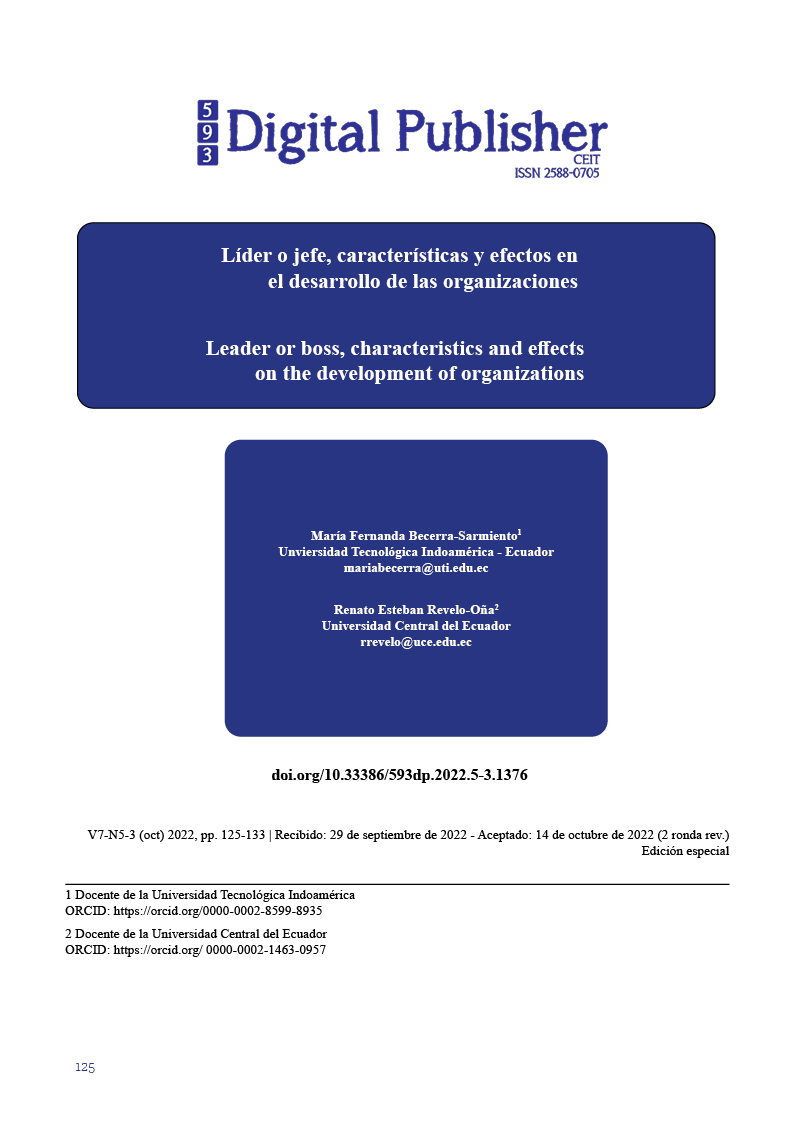Leader or boss, characteristics and effects on the development of organizations
Main Article Content
Abstract
The purpose of this research is to define the difference between leader and boss that is very marked by their way of acting that directly influences the result of organizational management. Method. Non-experimental explanatory research was applied to analyze the cause and effect of the behavior of the leader and the boss, in a meta-analytical review of the available literature and their connections between the leader and the boss with the JELY survey, to determine the characteristics of their behaviors were compared to determine significant differences and their effects for organizations. Results. The companies that have the best results are those that work as a team with leaders at the top, which does not happen with bosses who do not have a good work environment and do not always meet the goals. Discussion and Conclusions. A motivated staff with a leader at the head exceeds the proposed expectations, since the leader teaches how to reach the goal, unlike a boss who disposes and disposes the staff and does not provide the tools for its execution.
Downloads
Article Details

This work is licensed under a Creative Commons Attribution-NonCommercial-ShareAlike 4.0 International License.
1. Derechos de autor
Las obras que se publican en 593 Digital Publisher CEIT están sujetas a los siguientes términos:
1.1. 593 Digital Publisher CEIT, conserva los derechos patrimoniales (copyright) de las obras publicadas, favorece y permite la reutilización de las mismas bajo la licencia Licencia Creative Commons 4.0 de Reconocimiento-NoComercial-CompartirIgual 4.0, por lo cual se pueden copiar, usar, difundir, transmitir y exponer públicamente, siempre que:
1.1.a. Se cite la autoría y fuente original de su publicación (revista, editorial, URL).
1.1.b. No se usen para fines comerciales u onerosos.
1.1.c. Se mencione la existencia y especificaciones de esta licencia de uso.
References
Benavides, F. & Silva, M., 2022. Datos y evidencias del teletrabajo, antes y durante la pandemia por COVID-19. Archivos de prevención de riesgos laborales, 25(2).
Benjumea, M., Villa, E. & Valencia, J., 2016. Beneficios e impactos del teletrabajo en el talento humano. Resultados desde una revisión de literatura.. Revista CEA, 2(4), pp. 59-73.
Castellano, M., Caridad, M., Virviescas, J. & Martínez, J., 2017. Telework as a competitive labor strategy in Colombian PYME. Espacios, 38(31), p. 14.
Dávila, R., Agüero, E., Castro, L. & Vargas, A., 2022. Productividad laboral y el teletrabajo en el sector público durante el período de emergencia nacional. Universidad & Sociedad, 14(2), pp. 402-409.
Esquerda, M., 2021. Ventajas, inconvenientes y aspectos éticos del teletrabajo. FMC, 28(4), pp. 207-209.
Filadi, F., DeCastro, R. & Fundao, M., 2020. Ventajas y desventajas del teletrabajo en la administración pública brasileña: análisis de la expe-riencia del SERPRO y la Receita Federal. Cadernos EBAPE.BR, 18(1).
García, M., Silva, C., Salazar, J. & Gavilanez, F., 2021. Modalidad teletrabajo en tiempos de pandemia COVID-19 en Ecuador. Revista de Ciencias Sociales, 27(ESPECIAL 3), pp. 168-180.
Herrera, L., Torres, V. & Montenegro, M., 2021. Teletrabajo y pandemia. Análisis de las condiciones laborales en tiempos de covid-19. Encuentros: revista de Ciencias Humanas, Teoría Social y Pensamiento Crítico, Issue 14, pp. 141-148.
Institución Universitaria Esumer, 2018. El freelance y el teletrabajo: nuevas tendencias en el ámbito laboral. Revista Mercatec, pp. 46-54.
Martínez, R., 2012. Telecommuting as a labor market tendency. Retos, 2(4), pp. 144-155.
Miglioretti, M., Gragnano, A., Margheritti, S. & Picco, E., 2021. Not All Telework is Valuable. Journal of work and organizational Psychology, 37(1), pp. 11-19.
Morales, D. & Pérez, F., 2020. Teletrabajo como estrategia de competitividad y desarrollo para las empresas en el Ecuador. Revista Eruditus, 1(2), pp. 53-70.
Muñoz, A., 2020. El derecho a la desconexión digital en el teletrabajo. Trabajo y derecho: nueva revista de actualidad y relaciones laborales, 12(EXTRA).
Muñoz, F., 2021. The collective rights in teleworking. Trabajo y Derecho, Issue 79.
Ramírez, J. & Perdomo, M., 2019. VENTAJAS Y DESVENTAJAS DE LA IMPLEMENTACIÓN DEL TELETRABAJO, REVISIÓN DE LA LITERATURA.. Revista Competitivad e Innovación, 1(1).
Ramírez, J., Tapia, H. & Vega, C., 2021. Teletrabajo en Sudamérica: Un desafío juridio frente al covid-19. Revista Venezolana de Gerencia, 26(94), pp. 662-677.
Ramos, V., Ramos, C. & Tejera, E., 2020. Teleworking in times of COVID-19. Interamerican Journal of Psychology, 54(3).
Rolón, F. & Sánchez, S., 2018. El teletrabajo ¿una opción laboral acorde con las tendencias y exigencias del mercado o una figura con vacíos legislativos?. Dictamen Libre, Issue 22, pp. 103-122.
Ruiz, L., 2021. The new regulation of teleworking in public administrations: Between urgency and “minimum” flexibility in times of pandemic. Revista General de Derecho Administrativo, Volumen 57.
Sánchez, A., 2021. Effects of home-office on workers' well-being.. Revista de la Asociación Española de Especialistas en Medicina del Trabajo, 30(2), pp. 234-254.
Sanguineti, W., 2020. La noción jurídica de teletrabajo y el teletrabajo realmente existente. Trabajo y Derecho:nueva revista de actualidad y relaciones laborales, Issue 72.
Solís, J., Morocho, Á. & Quevedo, J., 2021. Tendencias del teletrabajo y el impacto en la productividad laboral. Una mirada desde el Covid-19. Gestión, Innovación y Calidad, pp. 307-338.
Tomasina, F. & Pisani, A., 2022. Pros and cons of teleworking in relation to the physical and mental health of the working general population: a narrative exploratory review. Archivos de prevención de riesgos laborales, 25(2).
Torres, P., 2021. Covid-19: Telework in times of pandemic. Historia y Comunicación Social, Volumen 26, pp. 11-18.
Ulate, R., 2020. Teletrabajo y su impacto en la productividad empresarial y la satisfacción laboral de los colaboradores: tendencias recientes.. Revista Tecnología En Marcha, 33(7), pp. 23-31.
Undurraga, R., Simburguer, E. & Mora, C., 2021. Desborde y desazón versus flexibilidad y concentración: Teletrabajo académico y género en tiempos de pandemia.. Polis Santiago, 20(59), pp. 12-38.
UniversidadPeruanadelasAméricas, 2017. Repositorio Institucional. [En línea]
Available at: http://190.119.244.198/handle/upa/156
Velázquez, C. & Vera, M., 2018. Teletrabajo: Una Revisión Teórica sobre sus Ventajas y Desventajas. Revista Investigatio, Issue 10, pp. 41-53.



